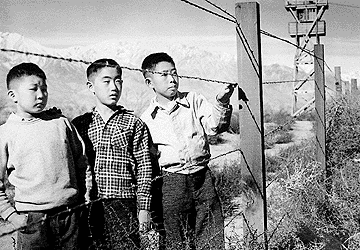On February 19, 1942, Executive Order 9066 was issued by the President of the United States. It authorized the internment (a less controversial term for imprisonment) of people of Japanese descent for the duration of World War II because of security worries. It had been considered by some to be a necessary precaution to be taken during a time of war. It is now considered to be one of the great miscarriages of justice in the history of this country.
The reason for this mass confinement on the West Coast had more to do with war hysteria compounded by racism, paranoia, and fear than it did any real threat. The 127,000 people who were incarcerated had done nothing wrong. They simply happened to be of Japanese heritage. They were small business owners and teachers and gardeners and stay-at-home moms. Not one crime had been committed. No spying at military installations. No sabotage of public works. No anti-American rhetoric. Sixty percent of them were American-born children and citizens of this country. Nonetheless, they were unceremoniously rounded up and shipped off to camps in remote inhospitable locations in Utah, Wyoming, Idaho, Arizona, Arkansas, and California.
These were not the camps of our typical American memories. There was no making of brightly colored lanyards during craft time, no canoeing on a lake or splashing around along its shore, no fun-filled days of games and evenings toasting s’mores around a campfire. Instead these camps boasted cramped bare barracks, some of them former horse stalls with spaces in the walls where the brutal winter wind could whistle through. Rationed food and a minimum of coal to provide heat throughout the frigid winters. Overcrowding and a constant lack of privacy. A surrounding fence bristling with barbed wire and armed guards manning 30-caliber machine guns in watchtowers. Not just for two weeks either but all year long, for years on end, taken away from home, friends, and all that had been familiar.
The names of these camps are most likely unfamiliar to the vast majority of Americans who were not affected by this action: Manzanar, Topaz, Tanforan, Heart Mountain. Given the euphemistic name Relocation Centers, these were prison camps plain and simple, and the bitter memories of those camps and what they signified lingered for decades for those who experienced them. They echo still in their descendants who know the stories all too well. Unfortunately, the rest of America knows or cares little about this sad chapter in our history.
And why not, some would say. Let the past be the past.
The past is indeed the past, but its lessons must not be forgotten, for as we have seen all too often throughout human history, the past will otherwise repeat itself.
When I taught eighth grade English, I came upon a story in our literature anthology entitled “The Bracelet.” Written by Yoshiko Uchida who as a young woman had been one of those imprisoned, it told the story of one girl’s life during the internment. The distress caused by this abrupt uprooting of families and the difficult adaptation to their harsh new environment could be felt through the experience of this young girl as she tried to cope with the pain and confusion of an inexplicable injustice.
I was told by my supervisor not to use the story. Apparently the district felt that our fourteen year old students didn’t have the capacity to understand (or perhaps the recognition that they would). I used the story anyway; it seemed wrong not to. Hiding from the unsettling truths of the past does not eliminate them. Learning about them might help prevent future occurrences.
The vast majority of the students knew little about that period of time. We examined together the mood of the country after the Pearl Harbor attack, discussed the newsreels shown in theaters across the country in the pre-TV era that portrayed the Japanese as ruthless killers, giving them a grotesque vermin-like appearance. We read articles that argued the pros and cons of imprisoning these people, including FBI director J. Edgar Hoover’s own opposition to this action. I ended the unit with a persuasive writing composition in which the students could argue either for or against Executive Order 9066. The vast majority were against this mass incarceration.
This was the case each year until 2001 when this academic exercise took on a very real spin. After the destruction of the World Trade Center towers, a new wave of hysteria swept over America, only this time it was not against the Japanese-Americans. What followed was an often ugly reaction against Muslim-Americans (or anyone mistaken for them). I am quite sure that if a new version of Executive Order 9066 had been proposed, great support would have been voiced. The fact that the targets of this outcry had nothing to do with the attack mattered little. If you are a member of a group, you bear the burden of complicity for the action of any member of the group regardless of the superficiality of the connection to it. Such is the nature of stereotype. Suddenly the rational arguments took on a whole new meaning, resulting in a reexamination of what once seemed such an obvious conclusion.
I have no solutions to offer as I reflect on this latest anniversary of the imprisonment of the Japanese-Americans. I wish I did. I will note the following, though. The last prison camp closed in 1946. In 1988, the Civil Liberties Act was signed into law. This legislation offered a formal apology to the Japanese-Americans wrongly incarcerated. It took forty-two years to do so. Restitution was also paid, $20,000 to each surviving victim, this the price deduced for the loss of homes, businesses, dignity, and four years of their lives. The Civil Liberties Act is now displayed alongside the original Executive Order 9066 at the National Archives.
John Tateishi, a Japanese-American involved in the movement which campaigned for redress, said, “You can make this mistake, but you also have to correct it — and by correcting it, hopefully not repeat it again.”
Only time will tell.



